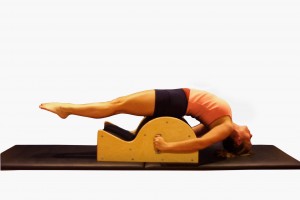Centerworks® “Secret” Training Tips for Mobilizing the Ribcage
Part Two: Spine Extension

It’s easy to bend the neck and low back, but it’s the upper thoracic, mid-back section that needs the attention to improve spine mobility. The older we get, the more gravity plays with our posture. Hunched over, heads jutted forward, we need our ribcage to move more freely, and our breath to truly support lifting our posture and lengthening our spine.
To do great back extension, everything you’ve been practicing for flexion happens in reverse. As the shoulder blades pull down, the breastbone has to slide up, out, and forward pulling the front ribs open and apart. As you start to “turn the collarbones” backwards, feel the back bones move forward (through the body) towards the breastbone, then use the back muscles to pull the back ribs closer together lifting the spine into extension. You are applying the “rotisserie” rib effect that you used for flexion to turn the ribs in the other direction.
It doesn’t matter whether you’re working on back extension face down, like Swan in Pilates Mat, or Down Stretch on the Reformer, exercises like Kneeling Cat, standing Spread Eagle, or your body is face up like Pull-Ups on the Cadillac, and the Leg Circles onto the Head exercise on the Spine Corrector shown above. The movement of the spine and ribcage is exactly the same for each of these exercises to facilitate extension. Yes, some exercises might start at the bottom of the spine and work up, while other exercises start from the head and work down, but to bend the spine, both the back bones and the ribcage has to move.
Interestingly, the chest muscles have to relax (and stretch) to move into extension also. There is a difference between “pinching the shoulder blades together” and actually moving the ribcage and spine into extension.
- If you allow the front of the ribcage to open, while the back ribs come closer together, you will be practicing spine extension.
- If you retract or “pinch” the blades together, you are moving the blades on the ribcage, NOT the ribcage and the spine. While you might “feel” your upper back working, you are not activating the right muscles for movement of the spine and freedom of the ribs.
Become consciously aware of feeling the counter-relationship between the front and back of the ribcage, where the ribs attach to the spine, and the movement of the breastbone to improve your spine extension. Move your shoulder blades less, and your spine and ribs more for easy, well-executed spine extension.
Click here to practice a spine extension exercise with this video.
******
Check out the entire Mobilizing the Ribcage Series:
- Pilates Training Tips to Mobilize the Ribcage for Better Functional Movement
- Spine Flexion
- Spine Rotation and Twisting
- Side Bend
- Healthy Spine Movement in Many Directions


0 Comments